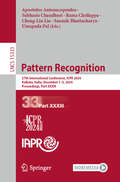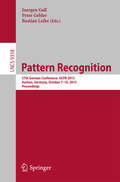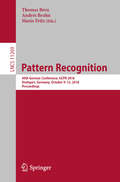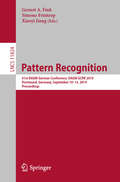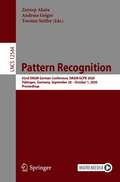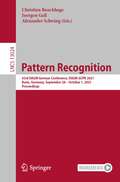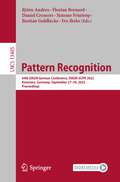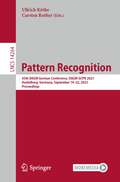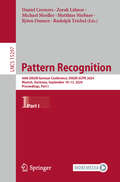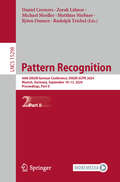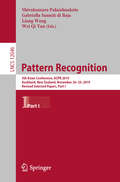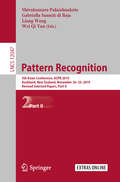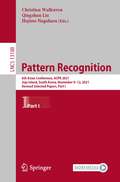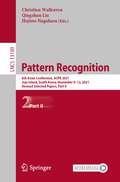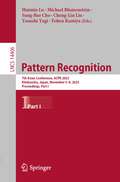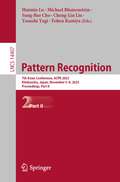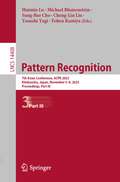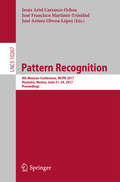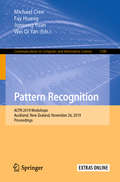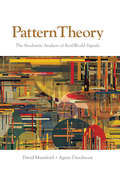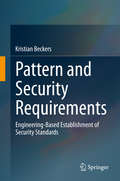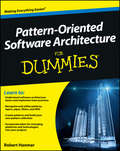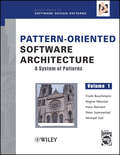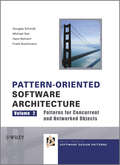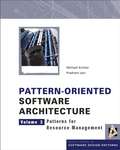- Table View
- List View
Pattern Recognition: 27th International Conference, ICPR 2024, Kolkata, India, December 1–5, 2024, Proceedings, Part XXXIII (Lecture Notes in Computer Science #15333)
by Rama Chellappa Subhasis Chaudhuri Cheng-Lin Liu Umapada Pal Apostolos Antonacopoulos Saumik BhattacharyaThe multi-volume set of LNCS books with volume numbers 15301-15334 constitutes the refereed proceedings of the 27th International Conference on Pattern Recognition, ICPR 2024, held in Kolkata, India, during December 1–5, 2024. The 963 papers presented in these proceedings were carefully reviewed and selected from a total of 2106 submissions. They deal with topics such as Pattern Recognition; Artificial Intelligence; Machine Learning; Computer Vision; Robot Vision; Machine Vision; Image Processing; Speech Processing; Signal Processing; Video Processing; Biometrics; Human-Computer Interaction (HCI); Document Analysis; Document Recognition; Biomedical Imaging; Bioinformatics.
Pattern Recognition: 37th German Conference, GCPR 2015, Aachen, Germany, October 7-10, 2015, Proceedings (Lecture Notes in Computer Science #9358)
by Juergen Gall Peter Gehler Bastian LeibeThis book constitutes the refereed proceedings of the 37th German Conference on Pattern Recognition, GCPR 2015, held in Aachen, Germany, in October 2015. The 45 revised full papers and one Young Researchers Forum presented were carefully reviewed and selected from 108 submissions. The papers are organized in topical sections on motion and reconstruction; mathematical foundations and image processing; biomedical image analysis and applications; human pose analysis; recognition and scene understanding.
Pattern Recognition: 40th German Conference, GCPR 2018, Stuttgart, Germany, October 9-12, 2018, Proceedings (Lecture Notes in Computer Science #11269)
by Andrés Bruhn Thomas Brox Mario FritzThis book constitutes the refereed proceedings of the 40th German Conference on Pattern Recognition, GCPR 2018, held in Stuttgart, Germany, in October 2018. The 48 revised full papers presented were carefully reviewed and selected from 118 submissions. The German Conference on Pattern Recognition is the annual symposium of the German Association for Pattern Recognition (DAGM). It is the national venue for recent advances in image processing, pattern recognition, and computer vision and it follows the long tradition of the DAGM conference series, which has been renamed to GCPR in 2013 to reflect its increasing internationalization. In 2018 in Stuttgart, the conference series celebrated its 40th anniversary.
Pattern Recognition: 41st DAGM German Conference, DAGM GCPR 2019, Dortmund, Germany, September 10–13, 2019, Proceedings (Lecture Notes in Computer Science #11824)
by Gernot A. Fink Xiaoyi Jiang Simone FrintropThis book constitutes the proceedings of the 41st DAGM German Conference on Pattern Recognition, DAGM GCPR 2019, held in Dortmund, Germany, in September 2019. The 43 revised full papers presented were carefully reviewed and selected from 91 submissions. The German Conference on Pattern Recognition is the annual symposium of the German Association for Pattern Recognition (DAGM). It is the national venue for recent advances in image processing, pattern recognition, and computer vision and it follows the long tradition of the DAGM conference series.
Pattern Recognition: 42nd DAGM German Conference, DAGM GCPR 2020, Tübingen, Germany, September 28 – October 1, 2020, Proceedings (Lecture Notes in Computer Science #12544)
by Zeynep Akata Andreas Geiger Torsten SattlerThis book constitutes the refereed proceedings of the 42nd German Conference on Pattern Recognition, DAGM GCPR 2020, which took place during September 28 until October 1, 2020. The conference was planned to take place in Tübingen, Germany, but had to change to an online format due to the COVID-19 pandemic.The 34 papers presented in this volume were carefully reviewed and selected from a total of 89 submissions. They were organized in topical sections named: Normalizing Flow, Semantics, Physics, Camera Calibration and Computer Vision, Pattern Recognition, Machine Learning.
Pattern Recognition: 43rd DAGM German Conference, DAGM GCPR 2021, Bonn, Germany, September 28 – October 1, 2021, Proceedings (Lecture Notes in Computer Science #13024)
by Juergen Gall Christian Bauckhage Alexander SchwingThis book constitutes the refereed proceedings of the 43rd DAGM German Conference on Pattern Recognition, DAGM GCPR 2021, which was held during September 28 – October 1, 2021. The conference was planned to take place in Bonn, Germany, but changed to a virtual event due to the COVID-19 pandemic.The 46 papers presented in this volume were carefully reviewed and selected from 116 submissions. They were organized in topical sections as follows: machine learning and optimization; actions, events, and segmentation; generative models and multimodal data; labeling and self-supervised learning; applications; and 3D modelling and reconstruction.
Pattern Recognition: 44th DAGM German Conference, DAGM GCPR 2022, Konstanz, Germany, September 27–30, 2022, Proceedings (Lecture Notes in Computer Science #13485)
by Daniel Cremers Simone Frintrop Björn Andres Florian Bernard Bastian Goldlücke Ivo IhrkeThis book constitutes the refereed proceedings of the 44th DAGM German Conference on Pattern Recognition, DAGM GCPR 2022, which was held during September 27 – 30, 2022.The 37 papers presented in this volume were carefully reviewed and selected from 78 submissions. They were organized in topical sections as follows: machine learning methods; unsupervised, semi-supervised and transfer learning; interpretable machine learning; low-level vision and computational photography; motion, pose estimation and tracking; 3D vision and stereo; detection and recognition; language and vision; scene understanding; photogrammetry and remote sensing; pattern recognition in the life and natural sciences; systems and applications.
Pattern Recognition: 45th DAGM German Conference, DAGM GCPR 2023, Heidelberg, Germany, September 19–22, 2023, Proceedings (Lecture Notes in Computer Science #14264)
by Carsten Rother Ullrich KötheThis book constitutes the proceedings of the 45th Annual Conference of the German Association for Pattern Recognition, DAGM-GCPR 2023, which took place in Heidelberg, Germany, during September 19-22, 2023. The 40 full papers included in these proceedings were carefully reviewed and selected from 76 submissions. They were organized in topical sections as follows: Segmentation and action recognition; 3D reconstruction and neural rendering; Photogrammetry and remote sensing; Pattern recognition in the life sciences; Interpretable machine learning; Weak supervision and online learning; Robust models.
Pattern Recognition: 46th DAGM German Conference, DAGM GCPR 2024, Munich, Germany, September 10–13, 2024, Proceedings, Part I (Lecture Notes in Computer Science #15297)
by Daniel Cremers Zorah Lähner Michael Moeller Matthias Nießner Björn Ommer Rudolph TriebelThis 2-volume set LNCS 15297-15298 constitutes the refereed proceedings of the 46th Annual Conference of the German Association for Pattern Recognition, DAGM-GCPR 2024, held in Munich, Germany, during September 10-13, 2024.The 44 full papers included in these proceedings were carefully reviewed and selected from 81 submissions. They are organized in these topical sections:Part I: Clustering and Segmentation; Learning Techniques; Medical and Biological Applications; Uncertainty and Explainability.Part II: Modelling of Faces and Shapes; Image Generation and Reconstruction; 3D Analysis and Sythesis; Video Analysis; Photogrammetry and Remote Sensing.
Pattern Recognition: 46th DAGM German Conference, DAGM GCPR 2024, Munich, Germany, September 10–13, 2024, Proceedings, Part II (Lecture Notes in Computer Science #15298)
by Daniel Cremers Zorah Lähner Michael Moeller Matthias Nießner Björn Ommer Rudolph TriebelThis 2-volume set LNCS 15297-15298 constitutes the refereed proceedings of the 46th Annual Conference of the German Association for Pattern Recognition, DAGM-GCPR 2024, held in Munich, Germany, during September 10-13, 2024.The 44 full papers included in these proceedings were carefully reviewed and selected from 81 submissions. They are organized in these topical sections:Part I: Clustering and Segmentation; Learning Techniques; Medical and Biological Applications; Uncertainty and Explainability.Part II: Modelling of Faces and Shapes; Image Generation and Reconstruction; 3D Analysis and Sythesis; Video Analysis; Photogrammetry and Remote Sensing.
Pattern Recognition: 5th Asian Conference, ACPR 2019, Auckland, New Zealand, November 26–29, 2019, Revised Selected Papers, Part I (Lecture Notes in Computer Science #12046)
by Liang Wang Wei Qi Yan Shivakumara Palaiahnakote Gabriella Sanniti di BajaThis two-volume set constitutes the proceedings of the 5th Asian Conference on ACPR 2019, held in Auckland, New Zealand, in November 2019. The 9 full papers presented in this volume were carefully reviewed and selected from 14 submissions. They cover topics such as: classification; action and video and motion; object detection and anomaly detection; segmentation, grouping and shape; face and body and biometrics; adversarial learning and networks; computational photography; learning theory and optimization; applications, medical and robotics; computer vision and robot vision; pattern recognition and machine learning; multi-media and signal processing; and interaction.
Pattern Recognition: 5th Asian Conference, ACPR 2019, Auckland, New Zealand, November 26–29, 2019, Revised Selected Papers, Part II (Lecture Notes in Computer Science #12047)
by Liang Wang Wei Qi Yan Shivakumara Palaiahnakote Gabriella Sanniti di BajaThis two-volume set constitutes the proceedings of the 5th Asian Conference on ACPR 2019, held in Auckland, New Zealand, in November 2019. The 9 full papers presented in this volume were carefully reviewed and selected from 14 submissions. They cover topics such as: classification; action and video and motion; object detection and anomaly detection; segmentation, grouping and shape; face and body and biometrics; adversarial learning and networks; computational photography; learning theory and optimization; applications, medical and robotics; computer vision and robot vision; pattern recognition and machine learning; multi-media and signal processing and interaction.
Pattern Recognition: 6th Asian Conference, ACPR 2021, Jeju Island, South Korea, November 9–12, 2021, Revised Selected Papers, Part I (Lecture Notes in Computer Science #13188)
by Qingshan Liu Christian Wallraven Hajime NagaharaThis two-volume set LNCS 13188 - 13189 constitutes the refereed proceedings of the 6th Asian Conference on Pattern Recognition, ACPR 2021, held in Jeju Island, South Korea, in November 2021. The 85 full papers presented were carefully reviewed and selected from 154 submissions. The papers are organized in topics on: classification, action and video and motion, object detection and anomaly, segmentation, grouping and shape, face and body and biometrics, adversarial learning and networks, computational photography, learning theory and optimization, applications, medical and robotics, computer vision and robot vision.
Pattern Recognition: 6th Asian Conference, ACPR 2021, Jeju Island, South Korea, November 9–12, 2021, Revised Selected Papers, Part II (Lecture Notes in Computer Science #13189)
by Qingshan Liu Christian Wallraven Hajime NagaharaThis two-volume set LNCS 13188 - 13189 constitutes the refereed proceedings of the 6th Asian Conference on Pattern Recognition, ACPR 2021, held in Jeju Island, South Korea, in November 2021. The 85 full papers presented were carefully reviewed and selected from 154 submissions. The papers are organized in topics on: classification, action and video and motion, object detection and anomaly, segmentation, grouping and shape, face and body and biometrics, adversarial learning and networks, computational photography, learning theory and optimization, applications, medical and robotics, computer vision and robot vision.
Pattern Recognition: 7th Asian Conference, ACPR 2023, Kitakyushu, Japan, November 5–8, 2023, Proceedings, Part I (Lecture Notes in Computer Science #14406)
by Huimin Lu Cheng-Lin Liu Michael Blumenstein Sung-Bae Cho Yasushi Yagi Tohru KamiyaThis three-volume set LNCS 14406-14408 constitutes the refereed proceedings of the 7th Asian Conference on Pattern Recognition, ACPR 2023, held in Kitakyushu, Japan, in November 2023. The 93 full papers presented were carefully reviewed and selected from 164 submissions. The conference focuses on four important areas of pattern recognition: pattern recognition and machine learning, computer vision and robot vision, signal processing, and media processing and interaction, covering various technical aspects.
Pattern Recognition: 7th Asian Conference, ACPR 2023, Kitakyushu, Japan, November 5–8, 2023, Proceedings, Part II (Lecture Notes in Computer Science #14407)
by Huimin Lu Cheng-Lin Liu Michael Blumenstein Sung-Bae Cho Yasushi Yagi Tohru KamiyaThis three-volume set LNCS 14406-14408 constitutes the refereed proceedings of the 7th Asian Conference on Pattern Recognition, ACPR 2023, held in Kitakyushu, Japan, in November 2023. The 93 full papers presented were carefully reviewed and selected from 164 submissions. The conference focuses on four important areas of pattern recognition: pattern recognition and machine learning, computer vision and robot vision, signal processing, and media processing and interaction, covering various technical aspects.
Pattern Recognition: 7th Asian Conference, ACPR 2023, Kitakyushu, Japan, November 5–8, 2023, Proceedings, Part III (Lecture Notes in Computer Science #14408)
by Huimin Lu Cheng-Lin Liu Michael Blumenstein Sung-Bae Cho Yasushi Yagi Tohru KamiyaThis three-volume set LNCS 14406-14408 constitutes the refereed proceedings of the 7th Asian Conference on Pattern Recognition, ACPR 2023, held in Kitakyushu, Japan, in November 2023. The 93 full papers presented were carefully reviewed and selected from 164 submissions. The conference focuses on four important areas of pattern recognition: pattern recognition and machine learning, computer vision and robot vision, signal processing, and media processing and interaction, covering various technical aspects.
Pattern Recognition: 9th Mexican Conference, MCPR 2017, Huatulco, Mexico, June 21-24, 2017, Proceedings (Lecture Notes in Computer Science #10267)
by Jesús Ariel Carrasco-Ochoa, José Francisco Martínez-Trinidad and José Arturo Olvera-LópezThis book constitutes the refereed proceedings of the 9th Mexican Conference on Pattern Recognition, MCPR 2017, held in Huatulco, Mexico, in June 2017. The 29 revised full papers presented were carefully reviewed and selected from 55 submissions. The papers are organized in topical sections on pattern recognition and artificial intelligence techniques, image processing and analysis, robotics and remote sensing, natural language processing and recognition, applications of pattern recognition.
Pattern Recognition: ACPR 2019 Workshops, Auckland, New Zealand, November 26, 2019, Proceedings (Communications in Computer and Information Science #1180)
by Junsong Yuan Wei Qi Yan Fay Huang Michael CreeThis volume constitutes the refereed proceedings, presented during the ACPR 2019 Workshops, held in Auckland, New Zealand, in November 2019. The 17 full papers and 6 short papers were carefully reviewed and selected out of numerous submissions. The papers are organized according to the topics of the workshops: computer vision for modern vehicles; advances and applications on generative deep learning models; image and pattern analysis for multidisciplinary computational anatomy; multi-sensor for action and gesture recognition; towards the automatic data processing chain for airborne and spaceborne sensors.
Pattern Theory: The Stochastic Analysis of Real-World Signals
by David Mumford Agnès DesolneuxPattern theory is a distinctive approach to the analysis of all forms of real-world signals. At its core is the design of a large variety of probabilistic models whose samples reproduce the look and feel of the real signals, their patterns, and their variability. Bayesian statistical inference then allows you to apply these models in the analysis o
Pattern and Security Requirements
by Kristian BeckersSecurity threats are a significant problem for information technology companies today. This book focuses on how to mitigate these threats by using security standards and provides ways to address associated problems faced by engineers caused by ambiguities in the standards. The security standards are analysed, fundamental concepts of the security standards presented, and the relations to the elementary concepts of security requirements engineering (SRE) methods explored. Using this knowledge, engineers can build customised methods that support the establishment of security standards. Standards such as Common Criteria or ISO 27001 are explored and several extensions are provided to well-known SRE methods such as Si*, CORAS, and UML4PF to support the establishment of these security standards. Through careful analysis of the activities demanded by the standards, for example the activities to establish an Information Security Management System (ISMS) in compliance with the ISO 27001 standard, methods are proposed which incorporate existing security requirement approaches and patterns. Understanding Pattern and Security Requirements engineering methods is important for software engineers, security analysts and other professionals that are tasked with establishing a security standard, as well as researchers who aim to investigate the problems with establishing security standards. The examples and explanations in this book are designed to be understandable by all these readers.
Pattern-Oriented Software Architecture For Dummies
by Robert HanmerImplement programming best practices from the ground upImagine how much easier it would be to solve a programming problem, if you had access to the best practices from all the top experts in the field, and you could follow the best design patterns that have evolved through the years. Well, now you can. This unique book offers development solutions ranging from high-level architectural patterns, to design patterns that apply to specific problems encountered after the overall structure has been designed, to idioms in specific programming languages--all in one, accessible, guide. Not only will you improve your understanding of software design, you'll also improve the programs you create and successfully take your development ideas to the next level.Pulls together the best design patterns and best practices for software design into one accessible guide to help you improve your programming projects Helps you avoid re-creating the wheel and also meet the ever-increasing pace of rev cycles, as well as the ever-increasing number of new platforms and technologies for mobile, web, and enterprise computing Fills a gap in the entry-level POSA market, as well as a need for guidance in implementing best practices from the ground upSave time and avoid headaches with your software development projects with Pattern-Oriented Software Architecture For Dummies.
Pattern-Oriented Software Architecture, A System of Patterns: A System Of Patterns (Wiley Software Patterns Series #1)
by Hans Rohnert Michael Stal Frank Buschmann Regine Meunier Peter SommerladPattern-oriented software architecture is a new approach to software development. This book represents the progression and evolution of the pattern approach into a system of patterns capable of describing and documenting large-scale applications. A pattern system provides, on one level, a pool of proven solutions to many recurring design problems. On another it shows how to combine individual patterns into heterogeneous structures and as such it can be used to facilitate a constructive development of software systems. Uniquely, the patterns that are presented in this book span several levels of abstraction, from high-level architectural patterns and medium-level design patterns to low-level idioms. The intention of, and motivation for, this book is to support both novices and experts in software development. Novices will gain from the experience inherent in pattern descriptions and experts will hopefully make use of, add to, extend and modify patterns to tailor them to their own needs. None of the pattern descriptions are cast in stone and, just as they are borne from experience, it is expected that further use will feed in and refine individual patterns and produce an evolving system of patterns. Visit our Web Page http://www.wiley.com/compbooks/
Pattern-Oriented Software Architecture, Patterns for Concurrent and Networked Objects: A System Of Patterns (Wiley Software Patterns Series #1)
by Hans Rohnert Douglas C. Schmidt Michael Stal Frank BuschmannDesigning application and middleware software to run in concurrent and networked environments is a significant challenge to software developers. The patterns catalogued in this second volume of Pattern-Oriented Software Architectures (POSA) form the basis of a pattern language that addresses issues associated with concurrency and networking. The book presents 17 interrelated patterns ranging from idioms through architectural designs. They cover core elements of building concurrent and network systems: service access and configuration, event handling, synchronization, and concurrency. All patterns present extensive examples and known uses in multiple programming languages, including C++, C, and Java. The book can be used to tackle specific software development problems or read from cover to cover to provide a fundamental understanding of the best practices for constructing concurrent and networked applications and middleware. About the AuthorsThis book has been written by the award winning team responsible for the first POSA volume "A System of Patterns", joined in this volume by Douglas C. Schmidt from University of California, Irvine (UCI), USA.Visit our Web Page
Pattern-Oriented Software Architecture, Patterns for Resource Management
by Prashant Jain Michael KircherThe first volume of the POSA pattern series introduced a broad-spectrum of general-purpose patterns in software design and architecture. The second narrowed the focus to fundamental patterns for building sophisticated concurrent and networked software systems and applications. This volume uses design patterns to present techniques for implementing effective resource management in a system.The patterns are covered in detail making use of several examples providing directions to the readers on how to implement the presented patterns. Additionally, the volume presents a thorough introduction into resource management and a case study where the patterns are applied to the domain of mobile radio networks. The patterns are grouped by different areas of resource management and hence address the complete lifecycle of resources: resource acquisition, coordination and release.
